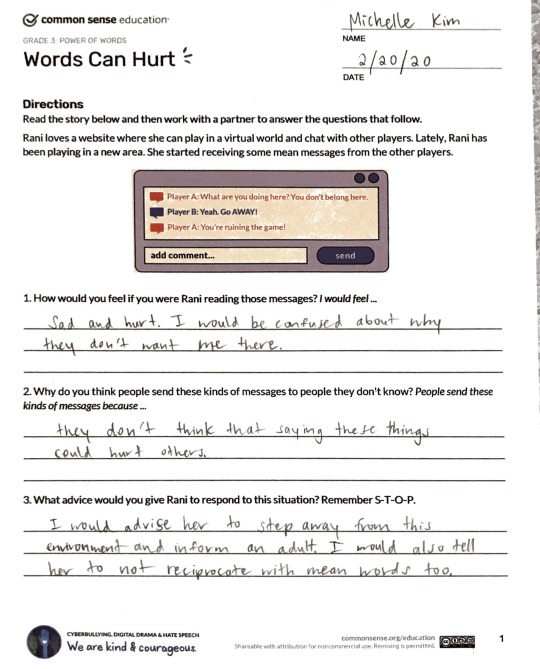#MediaLessonPlan
Explore tagged Tumblr posts
Text
Media Lesson Plan
Link: https://www.commonsense.org/education/digital-citizenship/lesson/the-power-of-words
The lesson that I chose to review is one that explores the subject of cyberbullying, with the lesson plan being made for the audience of 3rd graders. The title of the lesson is called, “The Power of Words,” and is meant to be teach young children about how to confront cyberbullying positively, but also about the necessity of empathy. The lesson teaches students to be careful about the words they choose to direct at others, because words can hold a lot of weight. The main aspects of the lesson are “Understand,” “Identify,” and “Decide.” This lesson begins with a warm up activity that introduces the students to how words can be interpreted differently based on how they are received by the audience. The activity also shares the aspect of words being shared online, because interpretations can be different between a face-to-face interaction and a cyber meeting. The next part of the lesson shares a video for the students to watch, which uses characters and a storyline to introduce cyberbullying in a gentle manner. The video’s main message is “STOP,” which is an anagram for “Step away,” “Tell a trusted adult,” “Okay sites first,” and “Pause and think online.” The video shares how empathy and kindness should be used to treat others with respect, rather than mean or harsh words. The next part of the lesson involves a handout titled, “Words Can Hurt,” which involves a scenario of cyberbullying and asks students to answer the discussion questions. The discussion questions directly ask the student of how they would feel if mean words were directed to them, why the cyberbullies would say mean things, and advice that they would give to the bullied girl. The last activity involves a piece of string that divides the room. One side of the strings represents the “OK” side and the “Not OK” side, which students are expected to choose to stand in when answering activity questions.
I think the lesson is very valuable and appropriately oriented to the audience. The audience includes 3rd graders, and they are learning more about how to monitor their behavior. Empathy isn’t something that can be taught with facts, thus it is important to put students in a scenario that exposes them to potential experiences. The video was very gentle in explaining how cyberbullying can affect others, and I like how they brought to attention the truth about the phrase, “Sticks and stones may break my bones, but words can never hurt me.” I also liked how the lesson not only taught the students to confront cyberbullying, but challenged them to think more deeply about how their words and actions have consequences. The activity that used the string in the middle of the room to represent what was appropriate or not is an activity that I actually saw in college. It’s interesting that the same activity that is used to draw in an audience of 3rd graders is also used to communicate with older students. The organization of the lesson was evenly portioned, and I liked the variety of aspects involved. All the parts, such as the warm up, the video, the handout, and the wrap up, all complemented each other well. If there was an imbalance of the parts involved, such as a long handout and no video, then the students might feel disengaged from the lesson. It’s important to have a physical activity that prompts the students to stand and actively participate with their bodies. This allows them to remember the content more clearly, and also helps them see how others perceive the same information given to them as well.


0 notes